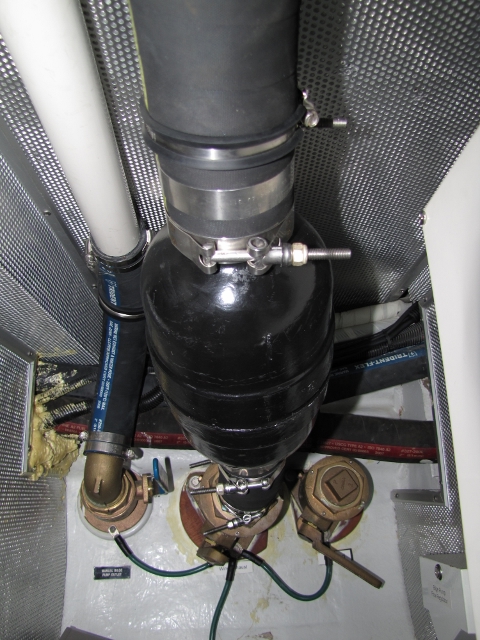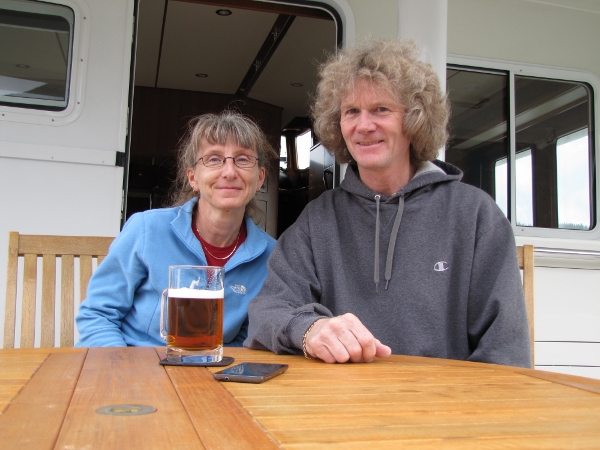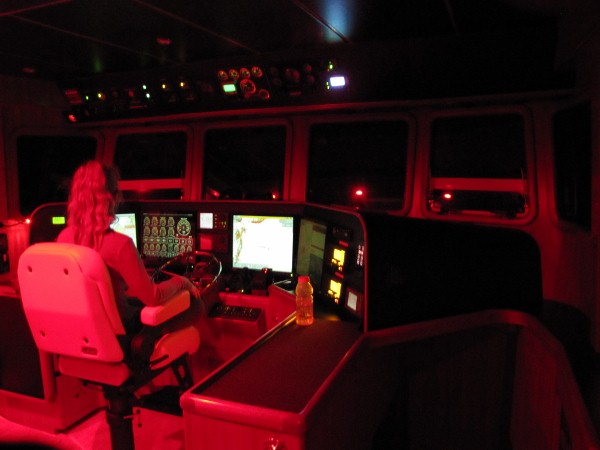Last week we gave a presentation on our trip to Prince William Sound to the Seattle Sail and Power Squadron. They meet on the third floor of the Queen City Yacht Club, with a wonderful view across Portage Bay. We had a great time socializing with the group and touring the grounds. For our talk, we described our trip pre-trip preparation, experiences on the offshore run, and highlights of cruising Prince William Sound. The slides are posted here. We’ll also be presenting on this topic at the Seattle Boat Show in January. The final schedule hasn’t yet been announced, but we’re slotted for January 28th or 29th. Below are our answer to a few questions from the audience on topics we didn’t specifically cover in the talk. What other failures did we have? In the presentation, we mentioned that a sea blubber jellyfish had plugged the generator raw-water strainer and destroyed the impeller. We replaced it, and immediately sucked in anther jellyfish, but this time the impeller wasn’t damaged, and we had no further issues. The only other major failure we had was the wing engine. We use it to run our hydraulic thrusters and windlass, and tried to start it as we were approaching the first anchorage after the offshore run. The engine wouldn’t start–turns out it was hydro-locked from having water forced down the raw-water exhaust outlet in the rough water. We cleared the engine, changed the oil twice and then ran it under load at anchor to get it good at hot. We got the water out quickly and the wing is undamaged. The most obvious way to avoid this problem is to close the seacock. Unfortunately, PAE doesn’t install a seacock on the generator or wing engine exhaust so that isn’t possible. Believing a seacock is a required safety feature, we have subsequently installed one. However, we like the wing to be available quickly in all conditions, so we prefer not to close the seacock. We instead installed a very large check valve in the exhaust, just inside the seacock, to prevent water inrush and wave action from driving water up the exhaust and into the engine. We believe this one is solved, but won’t know for sure until we experience difficult weather conditions. How tired were we when we arrived? We were in surprisingly good shape, despite the rough weather. On arriving at that first anchorage and finally stopping, we had no trouble taking on the wing engine issue, and had a nice relaxing dinner afterwards. We did sleep well that night though. This is something we’ve been finding with the Nordhavn: because travelling is so comfortable, we actually can go further in this boat in a given period of time, both multi-day and local trips, than we could in the previous boat, even though the Nordhavn’s top speed is much less. Running faster was more tiring on the previous boat. We’d have to be much more focused at the helm at the higher speeds, and the noise and vibration level, although not particularly bad, were significantly higher. Were there marked trails? It varied. In some places, such as at Cascade Bay, the trail above the waterfall was well-trod and easy to follow. In others, we could pick our way through open scrub in the general direction of our destination. Because the winter weather is so harsh in Alaska, forests don’t grow as thick as we’re use to in BC. The many bluffs and open fields in the hills around the anchorages in Prince William Sound provided plenty of opportunities for easy hiking with a view. What was the average temperature? Low-fifties near the glaciers, and low sixties elsewhere. Several days though, the temperature was into the seventies and was warm enough for us to eat lunch on deck in T-shirts. .jpg)
.jpg)
How did we arrive at our watchkeeping system? Beth Leonard and the Dashews have good coverage on the topic of two-crew watchkeeping systems. People frequently started at formal two-hour shifts for a 24-hour period, but then evolved to four-hour shifts, only at night, as they gained experience. We figured if we were going to evolve to four hours, we might as well start there. Most couples also seemed to have the person with the most helm experience do the majority of the night shifts. So for the trip to SE Alaska last year, we started out doing formal four-hour shifts at night, with James taking the 8pm-midnight and 4am-8am shifts, and me taking the midnight-4am shift. Days were to be more informal, with James sleeping once or twice during the day. We learned, however, that James doesn’t sleep well during the day, and wasn’t getting enough sleep. I, on the other hand, can sleep pretty much any time. So we swapped to me taking the first and last night shift, and James doing the middle shift. We found the 4-hour shifts slightly long so switched to 3 hours before settling on 3 ½ hours. I take the 8pm-11:30pm and 3:00am-6:30am shifts, and James takes 11:30pm-3:00am..jpg)
Cruising Prince William Sound
If your comment doesn't show up right away, send us email and we'll dredge it out of the spam filter.
Hi James, We are heading up to Alaska this spring and I am planning to install a check valve similar to yours on the wing exhaust. Could you please tell me the make and model you used.
Scolamanzi is a Nordhavn 60.
Congratulations on the successful crossing. We very much enjoy your blog. Brings back many memories. Did the same from Cape Town to Trinidad on our previous Scolamanzi – a Leopard 4600 sailing cat. Had a great time doing the crossing and in the Caribbean for 2 seasons.
Cheers to you both.
You are wise to be installing a check valve. It’s low cost protection. Flooding a wing is never a great idea but the biggest risk is that you flood it and don’t know it for a few weeks. That’s has been the end of many good engines.
This is the valve I’m using and it’s been working well for 5 years nowa: http://www.centekindustries.com/accessories.html. You likely haef a 2.5″ hose but I’m not positive on that point. That is what we are using.
James:
Thank you very much for the offer. It is an Olympia unit that will be installed on the N63. It won’t be here until the fall next year so I will contact you again closer to the date. I will also discuss the approach with Emerald as they plan things.
Thanks again for the insight.
Cheers
MB
Hi Murray. If you are using a Webasto or other small boiler, this is super easy to do. But, on a 63, you are likely using a larger boiler like the Olympia we have. If its an Olympia with its 120V control systems, its takes some work to figure out how to accomplish this. I can explain to you or Emerald Harbor Marine what I did when it comes time for you to do the work.
–James Hamilton
James:
Very interesting. I have a similar arrangement on my current boat (not a Nordhavn) but never thought about just shutting down the boiler and using the engine heat. I ran the boiler through the engines so the engines would be warm in the morning to start because I do a lot of winter boating but never thought about doing the reverse when running.
I am currently in the build process for a new N63 and was going to do a similar set-up but will now talk to Emerald about a similar shut-off switch.
Great tip. Thanks
MB
Good question Murray. Off shore we get heat from the diesel heat system with the boiler off but everything else in the heating system still running. We’ve set up a separate "boiler off" switch where we get heat only from the engine heat exchanger.
The hot water heat system gets heat from the boiler and the main engine through a heat exchanger so we shut off the boiler and still get heat from the engine when off shore. We also can turn on the generator and run the reverse cycle heat system but we haven’t been motivated to so far.
–James Hamilton
James:
Thanks for the response on the wing engine and boiler. Do you have an alternative heat source if you plug the boiler exhaust for passages. Does that mean you use the heat strips on the reverse cycle air conditioning when running offshore? Does it provide sufficient heat at high latitudes?
Thanks
Murray
Centek avoids increased back pressure by using a very large valve. Its about 6" in diameter but this avoids the back pressure problem and the expensive of increasing space consumption.
On the boiler, we put a plug in the exhaust when making passages. its not an issue on the generator as the exhaust goes up to a Gensep muffler many feet above the engine room before heading back down to the two through hulls.
–jrh
James/Jennifer:
Thanks. Did you consider back pressure when you added the check valve on the exhaust – any issue? Also did you have a similar problem with the exhaust on your boiler?
Cheers
MB
Bob, most of the anchorages in Prince William Sounds are not especially deep so standard rode lengths of 300 to 400′ are adequate. The picture at the top of the blog entry was an unusually deep anchorage. In that case, we were in 150′ on 485′ of rode but it was an exception.
We have 500′ of chain on Dirona.
–jrh
What lenght of Anchor chain do you need?
Murray,
We run the flood lights at night if no other traffic is nearby, or in the fog. Our experience with commercial fishing boats is that the floodlight can be seen from much greater distances than the navigation lights, particularly in thick fog. To reduce reflection off the foredeck, we installed shields below the floodlight and the steaming light. Some pictures are at //blog.mvdirona.com/2010/11/14/RunningAtNight.aspx
Filo,
Climbing onto an iceberg is generally not a sane idea, but this one was aground in the shallows north of Jade Harbor, so we felt it was pretty safe with little risk of it rolling over or moving. Just after I’d gotten back into the dinghy, however, several pieces of ice shot up close by from below the surface, like a submarine broaching. They must have detached from the main iceberg. The pieces were about the size of the dinghy and would have tipped us over if they’d hit it. You can see them in the inset picture on the bottom right–the bottom left picture was taken before the pieces surfaced. It had never occurred to us that pieces might break off like that below the surface and shoot up–so getting close even to a grounded iceberg is risky.
Jennifer
Did you run with your flood lights on at night? Only under certain conditions? How did you reduce reflection off the forward deck?
Thanks
Murray
Great write-up. How did you get to the mini-iceberg in Jade Harbor? How stable was it?